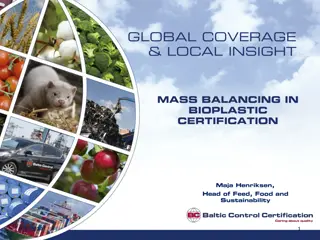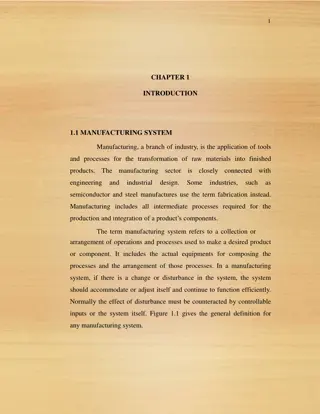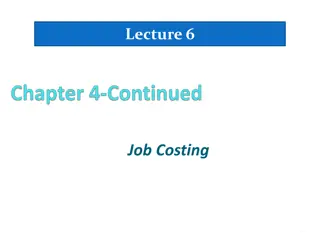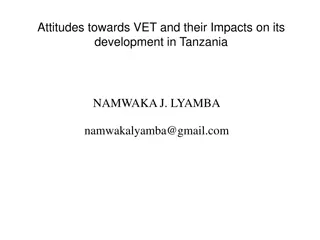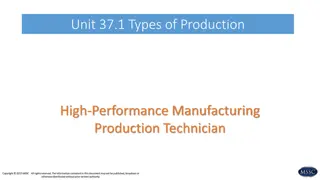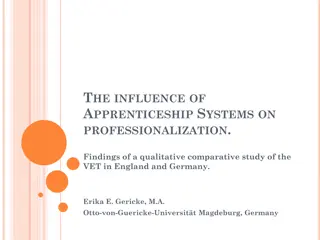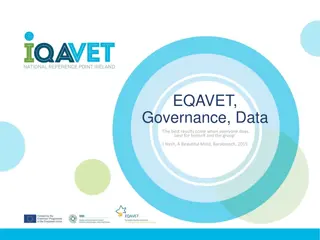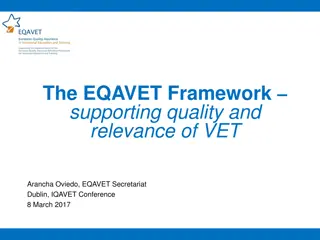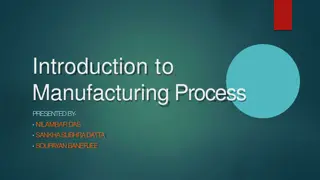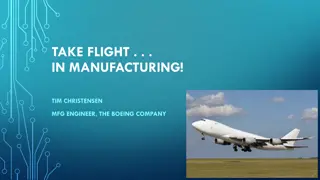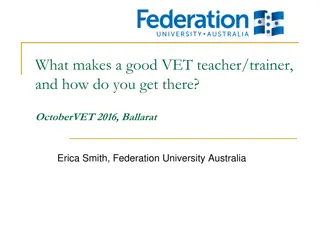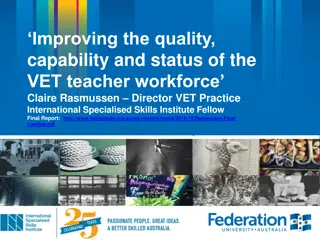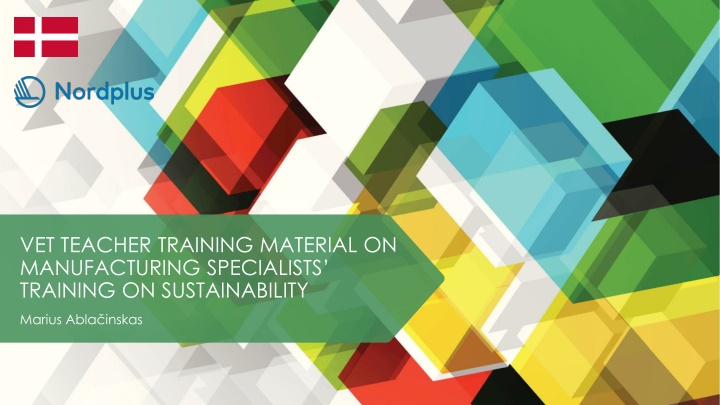
VET Teacher Training on Manufacturing Sustainability
Sustainability in manufacturing involves creating new products from raw materials while ensuring long-term reliance on natural resources. Understanding the lifecycle of manufacturing helps assess environmental impact and implement strategies like energy efficiency and carbon intensity reduction. Explore terms like circular economy, energy flexibility, and ISO 14001 standard in lean & green manufacturing practices.
Download Presentation

Please find below an Image/Link to download the presentation.
The content on the website is provided AS IS for your information and personal use only. It may not be sold, licensed, or shared on other websites without obtaining consent from the author. If you encounter any issues during the download, it is possible that the publisher has removed the file from their server.
You are allowed to download the files provided on this website for personal or commercial use, subject to the condition that they are used lawfully. All files are the property of their respective owners.
The content on the website is provided AS IS for your information and personal use only. It may not be sold, licensed, or shared on other websites without obtaining consent from the author.
E N D
Presentation Transcript
VET TEACHER TRAINING MATERIAL ON MANUFACTURING SPECIALISTS TRAINING ON SUSTAINABILITY Marius Abla inskas
TERMS Manufacturing jobs are defined as those that create new products either directly from raw materials or components. These jobs are usually in a factory, plant or mill but can also be in a home, as long as products, not services, are created. Sustainability is the ability to exist constantly. Sustainability means making only such use of natural, renewable resources that people can continue to rely on their yields in the long term. Environmental impact is defined as any change to the environment, whether adverse or beneficial, resulting from a facility s activities, products, or services. In other words it is the effect that people's actions have on the environment. Lifecycle of manufacturing works there are four stages in product manufacturing life cycle that include designing and developing the product, transferring technology to commercial-scale production, undertaking commercial manufacturing, and dealing with product discontinuation. Environmental impact includes, but not limits to carbon footprint. It is possible make a lifecycle assessment of a manufacturing works to find out how it will affect the environment in every stage of lifecycle. Carbon footprint the amount of carbon dioxide released into the atmosphere as a result of the activities of a particular individual, organization, or community. 3/12/2025
DEFINITIONS (1) Life cycle of manufacturing works whole existence or all stages starting from extraction of natural resources, transportation, production of materials or products, designing, manufacturing (assembly), use, repair, renovation, demolition, extraction and separation of waste to materials in the same composition or shape found in nature and put back to nature or put to the beginning of other life cycle. Circular economy an economic system aimed at eliminating waste and the continual use of resources. The circular economy aims to keep products, equipment and infrastructure in use for longer, thus improving the productivity of these resources. It does not mean a drop in the quality of life for consumers, it allowing us to keep enjoying similar products and services. Energy efficiency: reducing the energy required per unit of production. This reduces the energy cost by reducing the volumes used. Carbon intensity reduction: replacing the energy used with low carbon energy. This reduces the cost of CO2 emissions depending on local regulations and taxes. 3/12/2025
DEFINITIONS (2) Energy flexibility: adapting its energy use to market conditions (energy mix, level of consumption ) to optimise the purchase price. This will reduce the unit price of the energy used. Green Manufacturing, also known as Lean & Green, is an approach to evaluating and improving the manufacturing process. It s based on Lean manufacturing principles and thus provides a dynamic, proven, and successful approach to going green. ISO 14001 standard is defined as an international environmental management standard specifying requirements for establishing an environmental management policy, determining environmental impacts of products or services, planning environmental objectives, implementing programs to meet objectives, and conducting corrective action and management reviews. Implementation of requirements of the ISO 14001 standard shall be proved by third party certificate. 3/12/2025
GREEN VALUE STREAM APPROACH IN MANUFACTURING (1) The Green Manufacturing (also known as Lean & Green) framework is built around the 7 Green Value streams and offers a clear vision to strive for in each of them, for example reaching 100% renewable energy powered operations or zero waste sent to landfill. It s also important to note that there currently is no accreditation or external audits for implementing the Green Manufacturing framework. This framework is useful for manufacturers to improve their processes, track their progress and share that progress with stakeholders. The difference between Lean and Green is that in the case of Lean, waste is viewed from the customer perspective, and in the case of Green from the environment s perspective. The rest of the framework principles, processes, and tools are applied in the same way for both Lean and Green, which makes it familiar to manufacturers and therefore easy to apply in practice. 7 wastes of Lean (waste in a non-value-adding activity from the customers perspective): inventory, movement, defects, transportation, overproduction, excess processing, waiting. 7 Green wastes (waste is considered from the environmental perspective): energy, water, materials, transportation, waste to landfill, emissions, biodiversity. 3/12/2025
GREEN VALUE STREAM APPROACH IN MANUFACTURING (2) The Green Manufacturing (also known as Lean & Green) framework is built around the 7 Green Value streams and offers a clear vision to strive for in each of them, for example reaching 100% renewable energy powered operations or zero waste sent to landfill. It s also important to note that there currently is no accreditation or external audits for implementing the Green Manufacturing framework. This framework is useful for manufacturers to improve their processes, track their progress and share that progress with stakeholders. The difference between Lean and Green is that in the case of Lean, waste is viewed from the customer perspective, and in the case of Green from the environment s perspective. The rest of the framework principles, processes, and tools are applied in the same way for both Lean and Green, which makes it familiar to manufacturers and therefore easy to apply in practice. 7 wastes of Lean (waste in a non-value-adding activity from the customers perspective): inventory, movement, defects, transportation, overproduction, excess processing, waiting. 7 Green wastes (waste is considered from the environmental perspective): energy, water, materials, transportation, waste to landfill, emissions, biodiversity. 3/12/2025
WHAT ARE THE 7 GREEN WASTES? (1) 1. Energy. In this context, energy refers to electricity and fuels (such as natural gas) to power electrical and mechanical devices (e.g., machinery, electronics, heating, and cooling devices as well as ventilation systems). The most common issues with the energy subject are: 1) the wasteful overuse of energy; 2) the source of energy (renewable vs. non- renewable); 3) the fact that you have to buy the energy from someone else. 2. Water. Water, the second green waste, is essential for pretty much any company. However, manufacturers use and discharge a lot more of it than the average office building. Manufacturing industries that need a lot of water for product treatment include the garment and textile industry (for both growing cotton and dying process), industrial meat production, beverage industry (for both the water inside the drinks, but also for growing water-intense additive crops like sugar, coffee, fruit, etc), and automotive industry (for surface treatment and coating, paint spray booths, washing and rinsing, cooling and other processes). 3/12/2025
WHAT ARE THE 7 GREEN WASTES? (2) 3. Materials. The current linear flow of materials in the manufacturing process has created two challenges, both of which are affecting manufacturer profits and sustainability manufacturers constantly need new raw materials for production, and the product ends up in a landfill after its lifecycle. 4. Garbage. The environmental impact of garbage is well known. And so is the most common advice on eliminating it reduce, reuse, recycle. But there is an aspect that s rarely understood about this waste stream the actual cost of throwing things away. 5. Transportation. This green waste includes the transport of humans, materials, suppliers, and finished goods from one place to another. Its environmental impact is often overlooked, but in Europe alone, the transport sector represents almost a quarter of the greenhouse gas emissions and is the leading cause of air pollution in cities. 3/12/2025
WHAT ARE THE 7 GREEN WASTES? (3) 6. Emissions. To recap, many aspects contribute to the company s total carbon footprint. The wastes mentioned above would be taken into account when calculating the company s carbon footprint, but there are other impactful aspects to consider, for example: operations of an oven (baking often releases VOCs volatile organic compounds); HVAC (heating, ventilation, air conditioning systems); emissions caused directly by your product (e.g., if your product is a car, the emissions the product generates once used and at the end of its lifecycle). 7. Biodiversity. This is the last, but not least important waste for Green Manufacturers to consider as it affects both the sustainability of a business and the nature it s surrounded by. Biological diversity is the key to sustaining life on this planet. It s encompassing all living species on earth and their relationship to each other. It s how the trees, bees, plants, birds, and animals interact with each other, depend on each other and provide an ecosystem that can sustain life, generate oxygen, or clean water and soil. 3/12/2025
STEPS TO ELIMINATE GREEN WASTE Step 1: Gather data on the current situation. By gathering data from manufacturing business, the manufacturers can set a baseline. In the Energy waste context, manufacturers need to collect data on energy use and source for the whole factory and activity. In the Material waste context, manufacturers would identify the input/output of materials in each activity of the value stream. Sometimes this requires further information gathering, for example, the recyclability or material composition of materials or the type of waste. Step 2: Increase efficiency, minimize consumption. This is a crucial step that will help manufacturers successfully reach the next steps as it ensures manufacturing operations are as lean and efficient as possible. In this step, manufacturers identify where the opportunities lie for minimizing the use of resources e.g., switch to more efficient machinery to save energy or water, eliminate unnecessary packaging and reduce the creation of garbage. Often, this phase offers a fast (up to a year) payback period and cost savings after that. Step 3: Invest in bettering your business. The last step in the process is to leap towards the end goal mentioned in each category. With the savings from Step 2, there s at least part of the budget to invest in becoming a green manufacturer. The journey will look different for each aspect of the business and each business, but the end goal is the same to become a truly green manufacturer. 3/12/2025
SOCIAL ACTIVITY AND CULTURE The role of employer? The role of employee? The role of the VET centers and high schools? The role of the initiatives of pupils and students? 3/12/2025
OPPORTUNITIES & CHALLENGES OF SUSTAINABLE MANUFACTURING (1) Sustainable manufacturing is a mindset, first and foremost. At the moment, there s no one globally approved definition of which activities are sustainable and which are not. To evaluate it, activities must be viewed and considered in the context of environmental, social, and governance aspects. For example, it might not be sustainable to source lithium for battery manufacturing, but using e-scooters or e-bikes is part of solving the social challenge of more efficient transportation in the cities. In the context of manufacturing, a sustainable manufacturing process would in some way resemble how natural ecosystems work. A tree, for example, is consuming resources (nutrition from the soil, carbon dioxide, and sunlight) and is turning them into leaves, branches, and oxygen. All the waste the tree has (e.g., leaves in the autumn) it throws on the ground where with the help of the natural ecosystem, turn into nutrition for the tree and other plants. As of now, we haven t seen a manufacturing plant that would have managed to achieve this sort of process. 3/12/2025
OPPORTUNITIES & CHALLENGES OF SUSTAINABLE MANUFACTURING (2) A manufacturing plant that uses waste to create new materials while running on wind and solar energy would be an example of a sustainable manufacturing plant. It uses materials in the local environment and creates a product through the production process. The changing climate is already, directly and indirectly, impacting how we live and work and will increasingly continue to do that. Resources and energy prices are increasing and facing unseen before scarcity with no promise of change in this trend. This makes companies think about efficient and sustainable operations more than ever before. For example, some of our clients are monitoring their energy consumption in real-time in relation to their production output to see how energy use can be made more efficient as waste is eliminated. From a climate-related risk perspective, it s clear companies that understand their business risks from climate change can adequately prepare to mitigate them. 3/12/2025
OPPORTUNITIES & CHALLENGES OF SUSTAINABLE MANUFACTURING (3) Some examples of risks businesses see due to change are: revenue loss from customers hit by extreme weather events; supply chain disruptions due to floods, droughts, fires, or heat waves; carbon tax impact on the bottom line. And these are just a few of them, as each business is in its unique situation. All this creates a very good business reason for remodeling factory floors and making them greener, more efficient, and sustainable. To recap, solutions vary from case to case. Still, many are looking at ways to source materials from local suppliers, implementing more responsible sourcing of raw materials, or a plan for shifting to low-carbon operations. By the end of the day, a company running sustainable operations can weather the storm (literally) while competitors business is disrupted. Nonetheless, sustainable manufacturing practices can help save money and resources in the process. 3/12/2025
METHODS OF TRAINING (1) The teaching of sustainability in a particular training program may be a separate embedded module or a component of each module of the program content. This theme can also be presented in combination, with a greater part of the program introductory module and information inserts related to the content of each subject module. However, a separate (preferably introductory) module of the program is recommended for a consistent and effective presentation of the topic. 3/12/2025
METHODS OF TRAINING (2) Classroom-Based Training usually led by a teacher or qualified facilitator. Classroom learning takes place over one or more days in a physical venue on- or off-site. Groups of students or employees go through a series of presentation slides and activities, like case study assessments or information on environmental issues and requirements. The advantage of classroom-based training is that a group of students or employees can attain large amounts of knowledge at the same time. Unfortunately, most students and employees find this approach to training boring. Interactive Training is one of the most effective training methods in the workplace. Interactive training actively involves learners in their own learning experience. This training can take the form of simulations, scenarios, role plays, quizzes or games. By practicing their new skills and applying them in realistic work scenarios, learners are not only more engaged but more likely to retain what they ve learned, too. However, it can be time-consuming when done in person, especially when learners require regular feedback from a content expert With On-The-Job Training, not only are learners actively involved in learning, but they also participate in real activities that relate to their current or future job. This is one of the most effective training methods for succession planning. This type of training can result in rapid learning because learners are thrown into the proverbial deep end. This experience can be a little too stressful for some learners, let alone time-consuming, because of the frequent input required. 3/12/2025
EXPECTED RESULTS AND ASSESSMENT (1) After completing the sustainability module, the successful candidate is expected to: General competence: be able to communicate about professional issues relevant to environmental protection and sustainable use of resources, on a common level; be able to apply acquired knowledge and skills within new work tasks and atypical situations; be able to read a job descriptions and instructions, understanding where it is appropriate to apply the knowledge and skills gained. Knowledge: have general knowledge about environmental protection and sustainable use of resources; have general knowledge of the planning of environmental measures and the sustainable use of resources; have specialized knowledge about selected topics when dealing with different work tasks; have main qualification related knowledge of every mistake, failure, misuse influence to sustainability of manufacturing works. 3/12/2025
EXPECTED RESULTS AND ASSESSMENT (1) Skills: be able to comment and make suggestions on how to improve the company's environmental practices and sustainable resource management strategy; be able to identify the necessary measures and develop a plan for the application of environmental measures and the sustainable use of resources in a specific task; be able to identify operational challenges/problems in environmental measures and the sustainable use of resources plan and to assert the measures and methods to resolve these; be able to select relevant measures and methods for approaching a given environmental problem; be able to choose and use relevant tools or technology in implementing environmental problem solution methods. 3/12/2025


